Special Report
CDC Says These Places Are the Most Vulnerable to Disasters Like COVID Pandemic
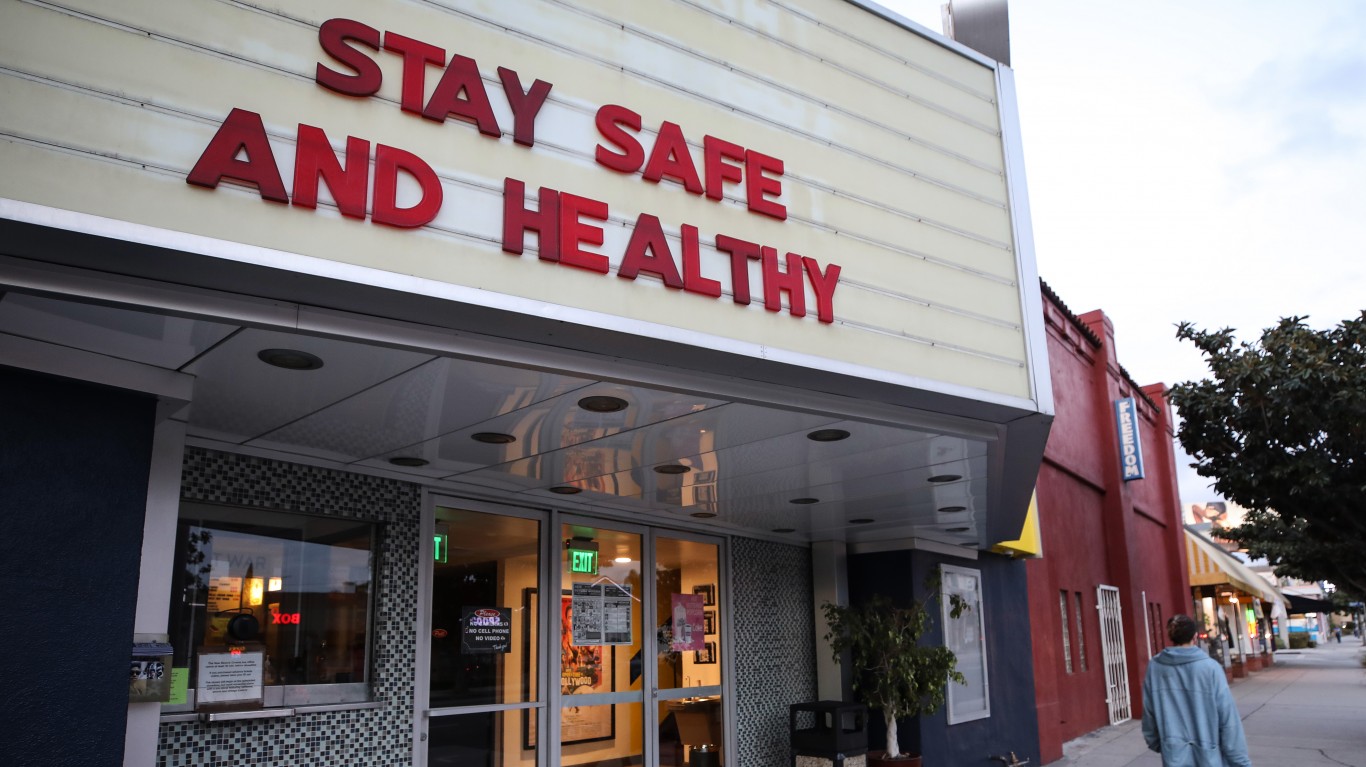
Published:
Last Updated:

As the United States enters its third month fighting the coronavirus pandemic, between 20,000 and 30,000 new cases have been diagnosed every day since the start of May. Even as data` remains highly limited, trends are beginning to emerge about which groups and parts of the United States are being hit the hardest — by the disease as well as economically.
Testing rates vary considerably between states and counties, making it difficult to assess the impact of the coronavirus on certain communities. In order to attempt to identify at-risk communities, 24/7 Wall St. reviewed the counties and county equivalent geographies that rank as the most vulnerable in the Centers for Disease Control and Prevention’s Social Vulnerability Index. The index uses data from 2018 to measure the ability of communities to prevent human suffering and financial loss when confronted with disasters or disease outbreaks.
The SVI uses 15 variables that fall into one of four categories: socioeconomic status, household composition and disability, minority status and language, and housing and transportation. These measures — which include poverty rates, unemployment, the presence of minorities or physically disabled populations, crowded housing, and populations living in institutions such as prisons or senior living centers — are one way of attempting to identify the counties that will be hit hardest by COVID-19 and could take the longest to recover.
Although many of the counties on this list may not be the urban, population-dense places Americans might associate with the outbreak, the majority have high numbers of diagnosed cases and deaths per capita.
In a conversation with 24/7 Wall St., Mark Siedner, associate professor of infectious diseases at Harvard University and clinician at Massachusetts General Hospital, explained that it made sense that these places identified as highly socially vulnerable would have high incidences of COVID-19 diagnoses and deaths.
“…the determinants of health for COVID-19 in this country are quite parallel,” he noted. “the clear reality for centuries [has been] that health and disease is socially determined […] COVID-19 has magnified that effect quite acutely, by showing the substandard, systematic barriers to healthcare access in this country.”
Many of the vulnerable groups included in the index have already been shown to have higher rates of vulnerability to COVID-19. For example, while the COVID-19 death rate among non-Hispanic white Americans is 45.2 per 100,000 people, it is 74.3 per 100,000 people identifying as Hispanic or Latino and 92.3 per 100,000 people identifying as Black or African American.
In one 2011 paper published in the Journal of Homeland Security and Emergency Management, CDC employees said, “The social and economic marginalization of certain racial and ethnic groups, including real estate discrimination, has rendered these populations more vulnerable at all stages of disaster.” Notably, a number of counties on this list are home to substantial American Indian populations, a group that has long struggled with the historical socioeconomic disadvantages that can be traced to their forced relocation by the U.S. government.
This includes McKinley County, New Mexico, which is home to part of the Navajo Nation and where nearly 80% of the population identifies as American Indian. The county has more COVID-19 cases per capita than the vast majority of U.S. counties.
Click here to see what places the CDC says are the most vulnerable to disasters like COVID pandemic.
Click here to see our methodology.

25. Hardee County, Florida
> Confirmed COVID-19 cases as of 5/5/2020: 33 (121.2 per 100,000)
> Poverty rate: 26.7% (highest 10%)
> Non-white population: 52.8% (highest 20%)
> Population with a disability: 10.1% (lowest 20%)
> Housing units with more people than rooms: 8.1% (highest 10%)
> Most populated place in county: Wauchula
When dealing with disasters, such as the current coronavirus pandemic, Hardee County, Florida, has one of the most vulnerable populations, according to the CDC’s social vulnerability index. Residents of the county are more likely to live in crowded homes, which might increase the risk of COVID-19 spread. More than 8% of occupied households have more occupants than rooms, one of the highest shares of any county, roughly four times that of the typical U.S. county. Hardee County also has an exceptionally high poverty rate.
[in-text-ad]
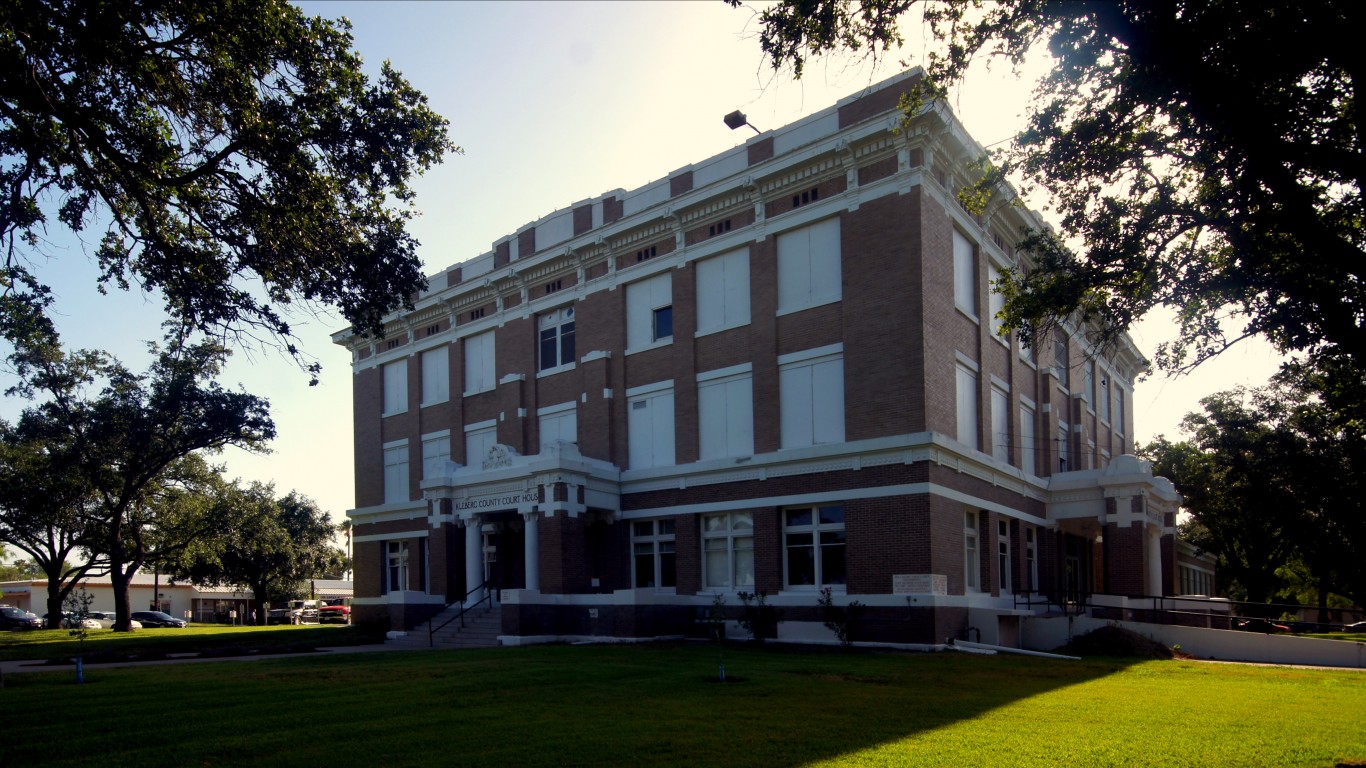
24. Kleberg County, Texas
> Confirmed COVID-19 cases as of 5/5/2020: 10 (31.8 per 100,000 — lowest 20%)
> Poverty rate: 26.1% (highest 10%)
> Non-white population: 79.6% (highest 10%)
> Population with a disability: 15.0%
> Housing units with more people than rooms: 6.4% (highest 10%)
> Most populated place in county: Kingsville
Americans living below the poverty line have extremely limited financial resources to cover expenses or loss of income during an emergency. In Kleberg County, Texas, more than one in every four residents live in poverty, a far higher poverty rate than the national rate.
Another measure indicative of heightened vulnerability during crises such as the COVID-19 pandemic in Kleberg County is its racial and ethnic composition. About 80% of the county’s population does not identify as white. Minorities in the United States are more likely to have some of the risk factors identified in the CDC’s vulnerability index, including a lack of secure housing or stable employment as well as low incomes — all factors that can contribute to elevated exposure to hardship during an emergency.
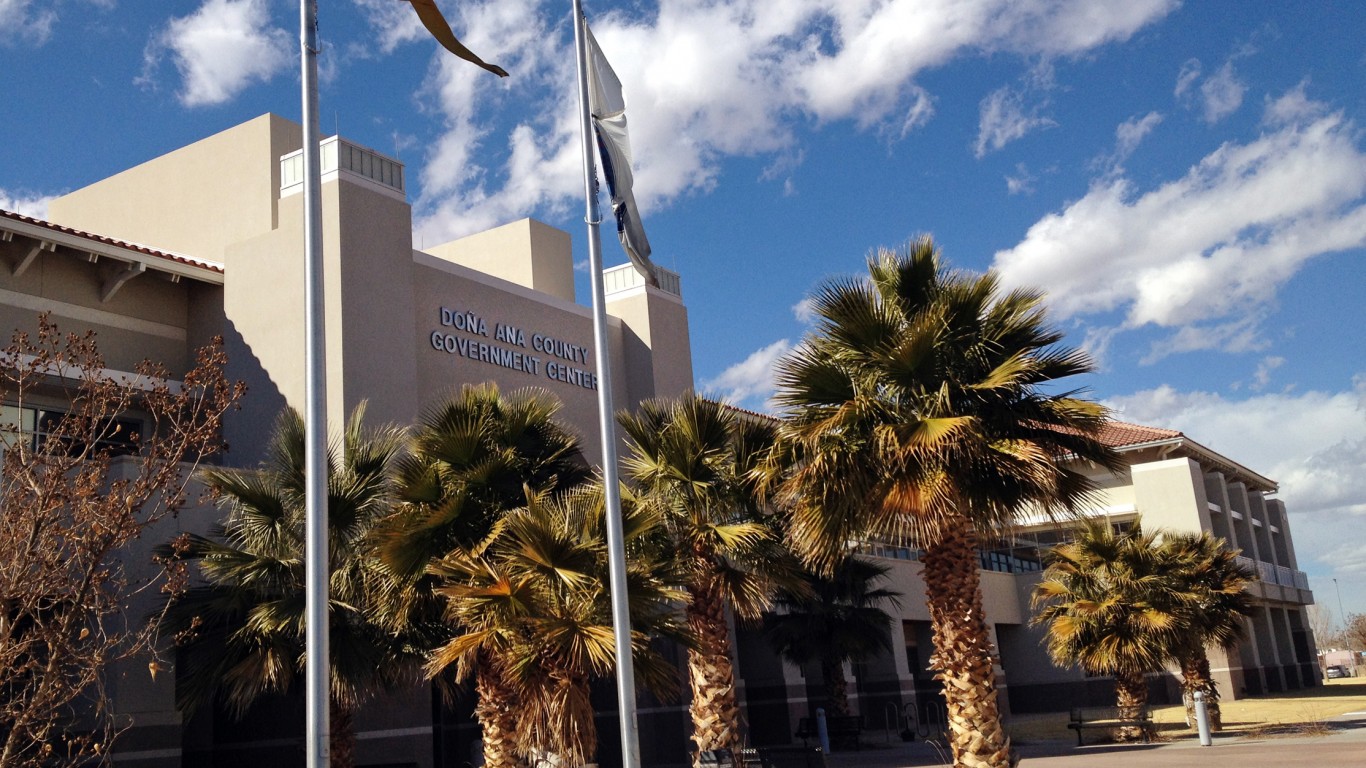
23. Doña Ana County, New Mexico
> Confirmed COVID-19 cases as of 5/5/2020: 170 (78.9 per 100,000)
> Poverty rate: 27.7% (highest 10%)
> Non-white population: 72.5% (highest 10%)
> Population with a disability: 13.7%
> Housing units with more people than rooms: 4.1% (highest 20%)
> Most populated place in county: Las Cruces
In Doña Ana County, New Mexico, more than one in every four residents are children. Younger Americans are particularly vulnerable in emergency situations. Many in the county are also highly exposed to the economic fallout of the COVID-19 crisis. An estimated 27.7% of county residents live below the poverty line, one of the highest rates of any county in New Mexico.
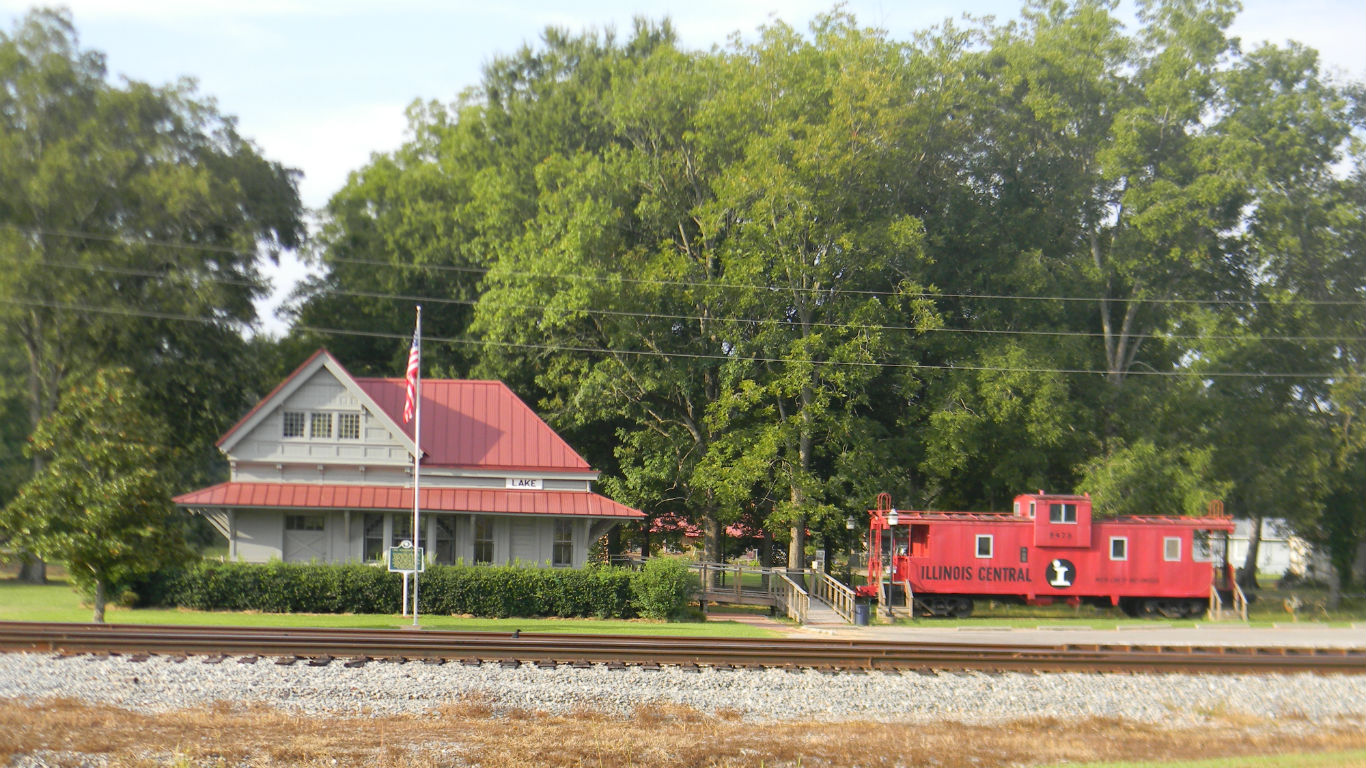
22. Scott County, Mississippi
> Confirmed COVID-19 cases as of 5/5/2020: 369 (1,298.6 per 100,000 — highest 10%)
> Poverty rate: 29.0% (highest 10%)
> Non-white population: 50.4% (highest 20%)
> Population with a disability: 23.0% (highest 10%)
> Housing units with more people than rooms: 4.7% (highest 10%)
> Most populated place in county: Forest
In Scott County, Mississippi, 23% of the population has a disability — either cognitive, physical, or sensory. Certain disabilities are accompanied with underlying conditions that can increase the risk of severe cases or even death among those contracting COVID-19.
Additionally, single-parent households often lack the resources — financial and otherwise — that two-parent households have to adjust to an emergency, and in Scott County, 16.5% of all households are single-parent, one of the largest shares of any U.S. county. According to the CDC, single-parent households are especially vulnerable in a disaster such as COVID-19 because all daily caretaker responsibility falls on one parent.
[in-text-ad-2]

21. San Miguel County, New Mexico
> Confirmed COVID-19 cases as of 5/5/2020: 02 (07.1 per 100,000 — lowest 10%)
> Poverty rate: 27.7% (highest 10%)
> Non-white population: 82.1% (highest 10%)
> Population with a disability: 28.5% (highest 10%)
> Housing units with more people than rooms: 1.9%
> Most populated place in county: Las Vegas
San Miguel County, New Mexico, is one of the few counties on this list to have a relatively low incidence of COVID-19 so far, with just two confirmed cases as of the time of this writing. The county also reports one of the higher COVID testing rates compared to other US counties. However, New Mexico has recorded one of the faster increases in coronavirus cases among states lately, and if the county is affected, it has one of the most vulnerable populations, according to the CDC.
The county’s poverty rate of 27.7% is one of the higher rates in both the state and the country. According to the CDC, poor Americans are less likely to be able to stockpile food, and less likely to have access to time off from work.
20. Marlboro County, South Carolina
> Confirmed COVID-19 cases as of 5/5/2020: 52 (191.7 per 100,000)
> Poverty rate: 26.0% (highest 10%)
> Non-white population: 60.8% (highest 10%)
> Population with a disability: 21.6% (highest 10%)
> Housing units with more people than rooms: 3.0%
> Most populated place in county: Bennettsville
About 10% of residents of Marlboro County, South Carolina, are institutionalized in group quarters, including nursing homes and correctional facilities. These places tend to be high risk areas for COVID-19 infection. The share of a county’s population housed by institutions is typically less than 2%.
The county, which is located in the northeastern part of the state, has high shares of people with disabilities, living in poverty, in a household without a vehicle, and other groups who fall into categories considered especially vulnerable during crises such as a pandemic.
[in-text-ad]

19. Pike County, Mississippi
> Confirmed COVID-19 cases as of 5/5/2020: 155 (390.1 per 100,000 — highest 20%)
> Poverty rate: 33.8% (highest 10%)
> Non-white population: 56.4% (highest 10%)
> Population with a disability: 17.1%
> Housing units with more people than rooms: 2.6%
> Most populated place in county: McComb
During the COVID-19 crisis, many Americans are increasingly financially vulnerable — particularly those who were struggling to begin with. In Pike County, Mississippi, more than one in every three residents live below the poverty line, one of the highest poverty rates of any U.S. county.
Like many counties on this list, children — who according to the CDC are more likely to be dependent on others and less likely to adjust well to emergency situations — comprise a relatively large proportion of the county’s population. An estimated 26.3% of Pike County residents are younger than 18, a far larger share than in most counties.
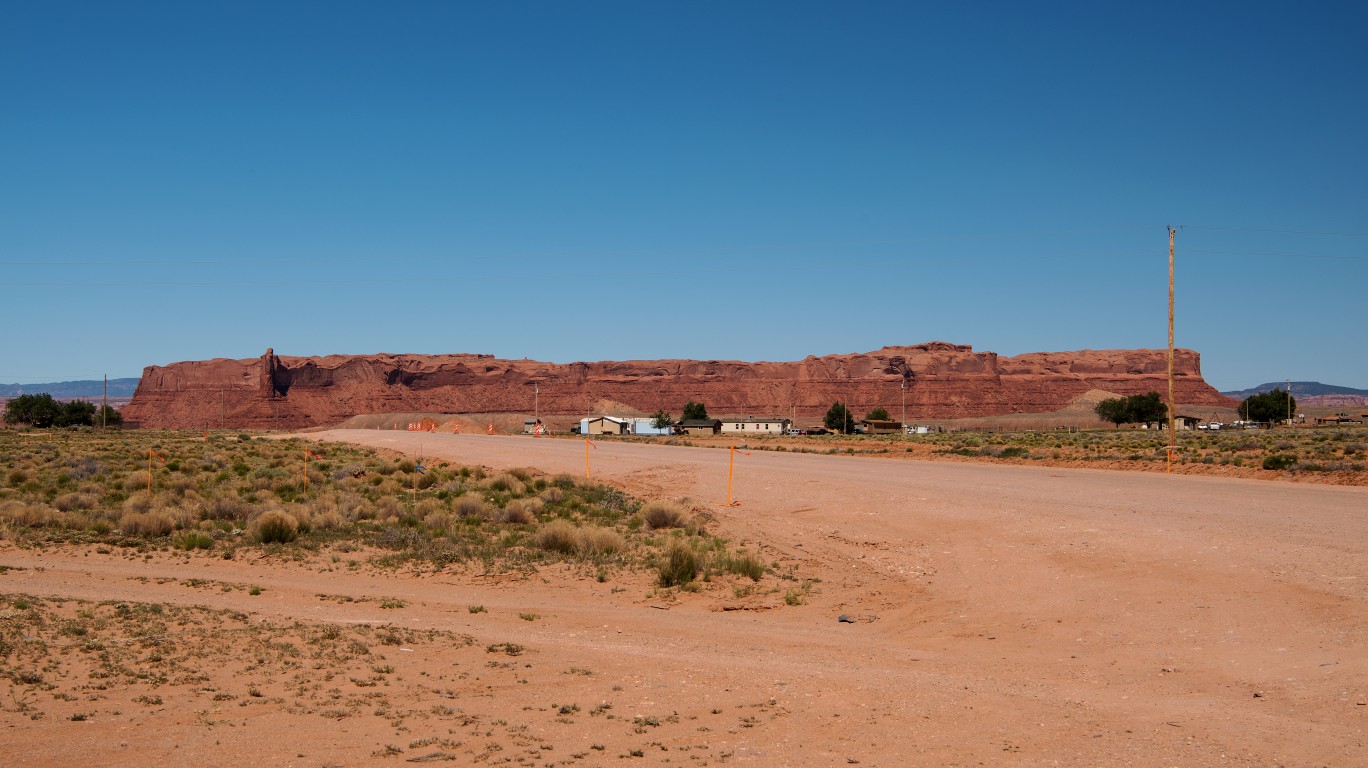
18. Apache County, Arizona
> Confirmed COVID-19 cases as of 5/5/2020: 549 (767.6 per 100,000 — highest 10%)
> Poverty rate: 35.3% (highest 10%)
> Non-white population: 81.7% (highest 10%)
> Population with a disability: 14.7%
> Housing units with more people than rooms: 13.1% (highest 10%)
> Most populated place in county: Chinle
Apache County is located in the northeastern corner of Arizona, sharing a border with Utah and New Mexico. The Navajo Nation Reservation contains much of Apache County, and Native Americans in the United States have long faced serious economic disadvantages, including generational poverty.
An estimated 35.5% of the county’s population lives in poverty, one of the highest poverty rates of any U.S. county. According to the CDC, people living in poverty are much less likely to have the financial resources needed to prepare for a disaster like a pandemic, and are less likely to have safety nets such as investments or savings to mitigate the loss of work.
17. McKinley County, New Mexico
> Confirmed COVID-19 cases as of 5/5/2020: 1,233 (1,692.5 per 100,000 — highest 10%)
> Poverty rate: 36.0% (highest 10%)
> Non-white population: 91.2% (highest 10%)
> Population with a disability: 16.7%
> Housing units with more people than rooms: 13.5% (highest 10%)
> Most populated place in county: Gallup
McKinley County, New Mexico, is one of just a few U.S. counties where more than 90% of the population is non-white. According to the CDC, certain racial minority groups in the U.S. are especially vulnerable to the effects of disasters, including pandemics. As of May 5, the county had 1,233 reported cases of COVID-19, which, relative to its relatively small population of roughly 72,000 people, is one of the highest COVID case loads of any place in the country.
Even before the economic effects of the pandemic took place and more than 30 million Americans filed for unemployment benefits, unemployment was extremely high in the county, at 15.7% on average in 2018 — and it has likely gone up over the last two months. Because it is so common to receive health insurance through an employer, the already high percentage of county residents without health insurance in McKinley has likely also gone up over the last two months. In 2018, over 20% of the county’s residents did not have health insurance, one of relatively few U.S. counties for which this is the case.
[in-text-ad-2]

16. Yuma County, Arizona
> Confirmed COVID-19 cases as of 5/5/2020: 110 (52.9 per 100,000)
> Poverty rate: 20.1% (highest 20%)
> Non-white population: 68.6% (highest 10%)
> Population with a disability: 12.0%
> Housing units with more people than rooms: 7.0% (highest 10%)
> Most populated place in county: Yuma
Though the relationship between education and vulnerability to disaster is complicated, people with higher educational attainment are more likely to have access to information in an emergency situation, according to the CDC and are less likely to be poor. In Arizona’s Yuma County, nearly 28% of adults do not have a high school diploma, one of the largest shares of any county in the United States.

15. Gadsden County, Florida
> Confirmed COVID-19 cases as of 5/5/2020: 113 (245.6 per 100,000)
> Poverty rate: 24.6% (highest 10%)
> Non-white population: 67.5% (highest 10%)
> Population with a disability: 20.1% (highest 10%)
> Housing units with more people than rooms: 3.4% (highest 20%)
> Most populated place in county: Quincy
Like all of the counties on this list, Gadsden County, Florida, is home to a large non-white population, a group that the CDC identifies as being more at risk for the worst effects of a serious crisis. The CDC has found that racial and ethnic minority groups in the U.S. have been disproportionately affected by COVID-19, with substantially higher death rates among black and Hispanic Americans than among white Americans.
Compared to the typical U.S. county, a much larger share of Gadsden residents live in housing situations that according to the CDC put them more at risk during crises such as COVID-19. The county has among the country’s highest shares of residents who are housed in nursing homes, prisons, or in other institutionalized group quarters (8.4%), and of households with no access to a vehicle (11.7%).
[in-text-ad]

14. Robeson County, North Carolina
> Confirmed COVID-19 cases as of 5/5/2020: 204 (152.9 per 100,000)
> Poverty rate: 28.1% (highest 10%)
> Non-white population: 74.5% (highest 10%)
> Population with a disability: 16.5%
> Housing units with more people than rooms: 3.6% (highest 20%)
> Most populated place in county: Lumberton
Minorities in the United States are especially vulnerable to the effects of disasters, including pandemics, according to the CDC. In Robeson County, about three-quarters of the population identifies as a non-white minority group. Many county residents also lack the financial resources to support themselves as a staggering 28.1% of the population live below the poverty line.
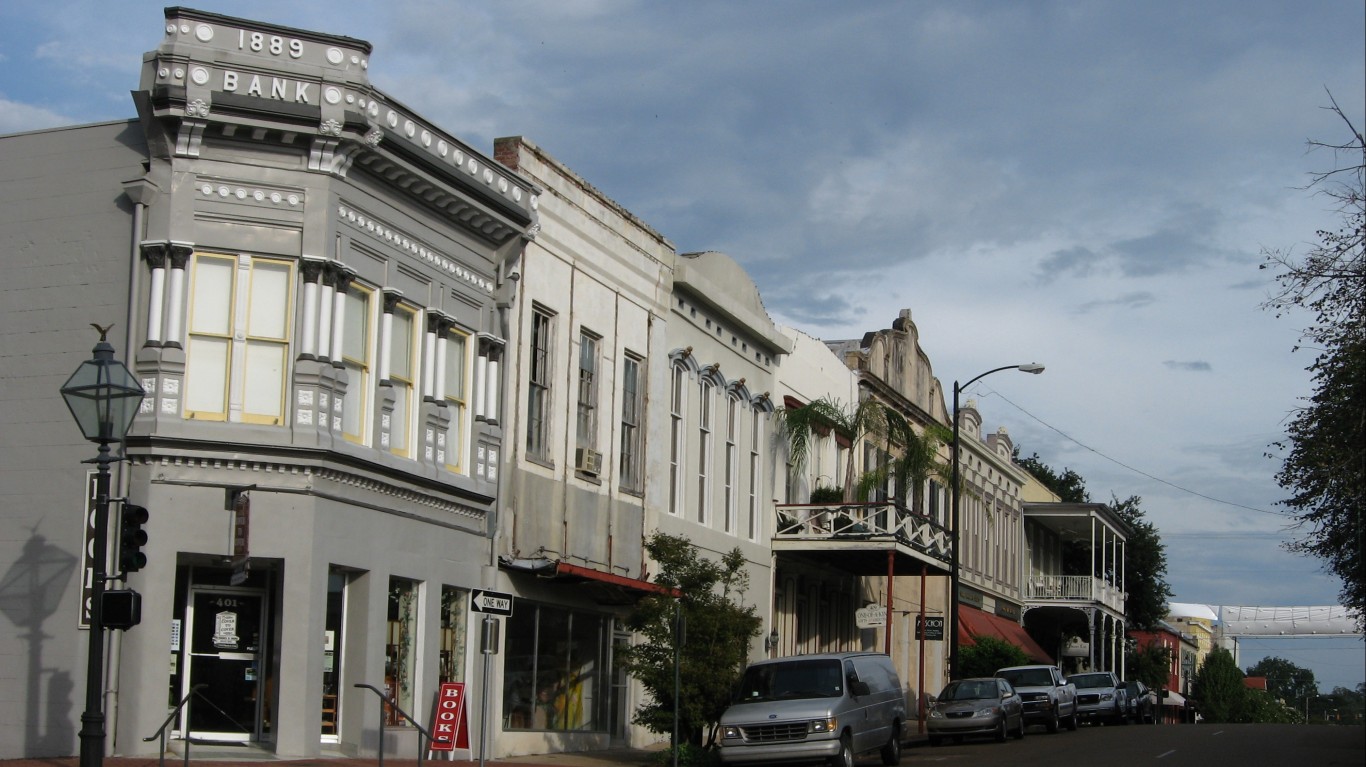
13. Adams County, Mississippi
> Confirmed COVID-19 cases as of 5/5/2020: 149 (472.3 per 100,000 — highest 10%)
> Poverty rate: 34.3% (highest 10%)
> Non-white population: 63.8% (highest 10%)
> Population with a disability: 16.6%
> Housing units with more people than rooms: 2.4%
> Most populated place in county: Natchez
Adams County, located in southwestern Mississippi along the Mississippi River, is one of several counties in the state to rank on this list. One of the poorest counties in the country, more than a third of the population lives below the poverty line — meaning that even during normal times, without the additional strain and financial uncertainty of an emergency such as this one, a significant portion of the population struggles to afford basic necessities.
The county is also home to a large share of residents who are particularly vulnerable during the COVID-19 pandemic, when social distancing is critical to reducing the spread of the virus and the chances of contracting the disease. More than 8.0% of county residents live in institutionalized group quarters where maintaining a safe physical distance from others can be difficult, this is one of the higher shares among U.S. counties.
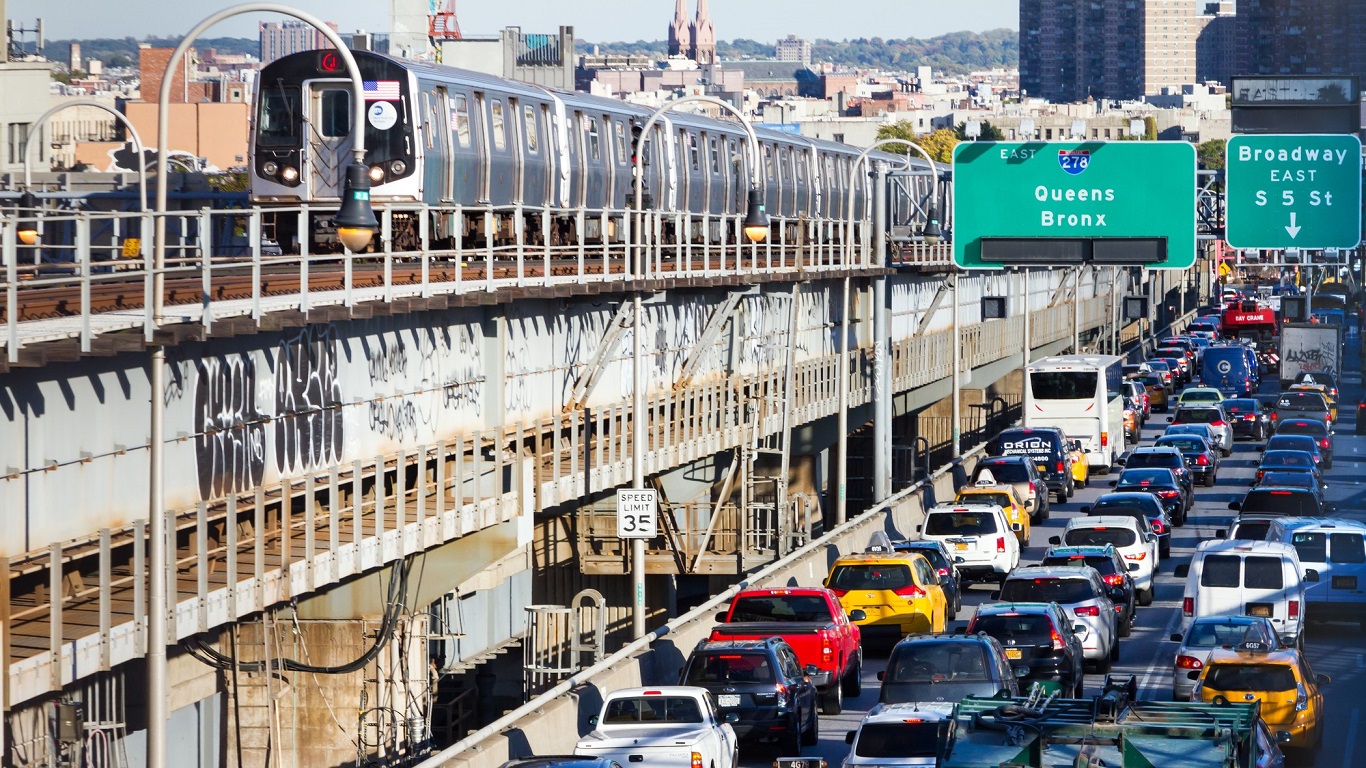
12. Bronx County, New York
> Confirmed COVID-19 cases as of 5/5/2020: 39,223 (2,727.9 per 100,000 — highest 10%)
> Poverty rate: 29.1% (highest 10%)
> Non-white population: 90.7% (highest 10%)
> Population with a disability: 14.8%
> Housing units with more people than rooms: 12.3% (highest 10%)
> Most populated place in county: New York
Bronx County, New York, is coterminous with the New York City borough of the same name. The area has been among the hardest hit by the coronavirus pandemic. There have been nearly 40,000 cases reported as of April 5, the third most of any U.S. county. Many county residents are particularly vulnerable as 12.3% of the population lives in housing units with fewer rooms than people, making safe social distancing especially difficult.
According to the CDC, minorities in the United States are especially vulnerable to the effects of disasters, including pandemics. In Bronx, more than 90% of the population belongs to a non-white minority group.
[in-text-ad-2]

11. Lenoir County, North Carolina
> Confirmed COVID-19 cases as of 5/5/2020: 84 (146.8 per 100,000)
> Poverty rate: 23.0% (highest 10%)
> Non-white population: 50.6% (highest 20%)
> Population with a disability: 23.8% (highest 10%)
> Housing units with more people than rooms: 2.5%
> Most populated place in county: Kinston
Close to one in four residents of Lenoir County, North Carolina, have a disability of some kind, much higher than the typical county, where about one in six have some form of disability. According to the CDC, while people with disabilities are not necessarily at higher risk of severe COVID-19 disease, some people with disabilities might be at greater risk due to underlying conditions such as chronic lung disease or a weakened immune system.
Like most of the other counties on this list, Lenoir has among the highest poverty rates in the country. The county also had one of the higher unemployment rates even before the recent massive layoffs took place.
10. Scotland County, North Carolina
> Confirmed COVID-19 cases as of 5/5/2020: 30 (85.1 per 100,000)
> Poverty rate: 27.7% (highest 10%)
> Non-white population: 56.4% (highest 10%)
> Population with a disability: 17.9%
> Housing units with more people than rooms: 4.4% (highest 10%)
> Most populated place in county: Laurinburg
Compared to the typical U.S. county, a much larger share of Scotland County residents live in housing situations that according to the CDC put them at higher risk during crises such as COVID-19. The county has among the highest shares in the country of residents who do not have access to a vehicle, who live in crowded housing units with more people than available rooms, or who are institutionalized in group quarters.
The county also has a per capita income of just $18,242, one of the lowest figures in the United States. It is one of just three North Carolina counties with a per capita income of less than $20,000. Low-income individuals are especially vulnerable to the economic effects of a crisis like a pandemic.
[in-text-ad]
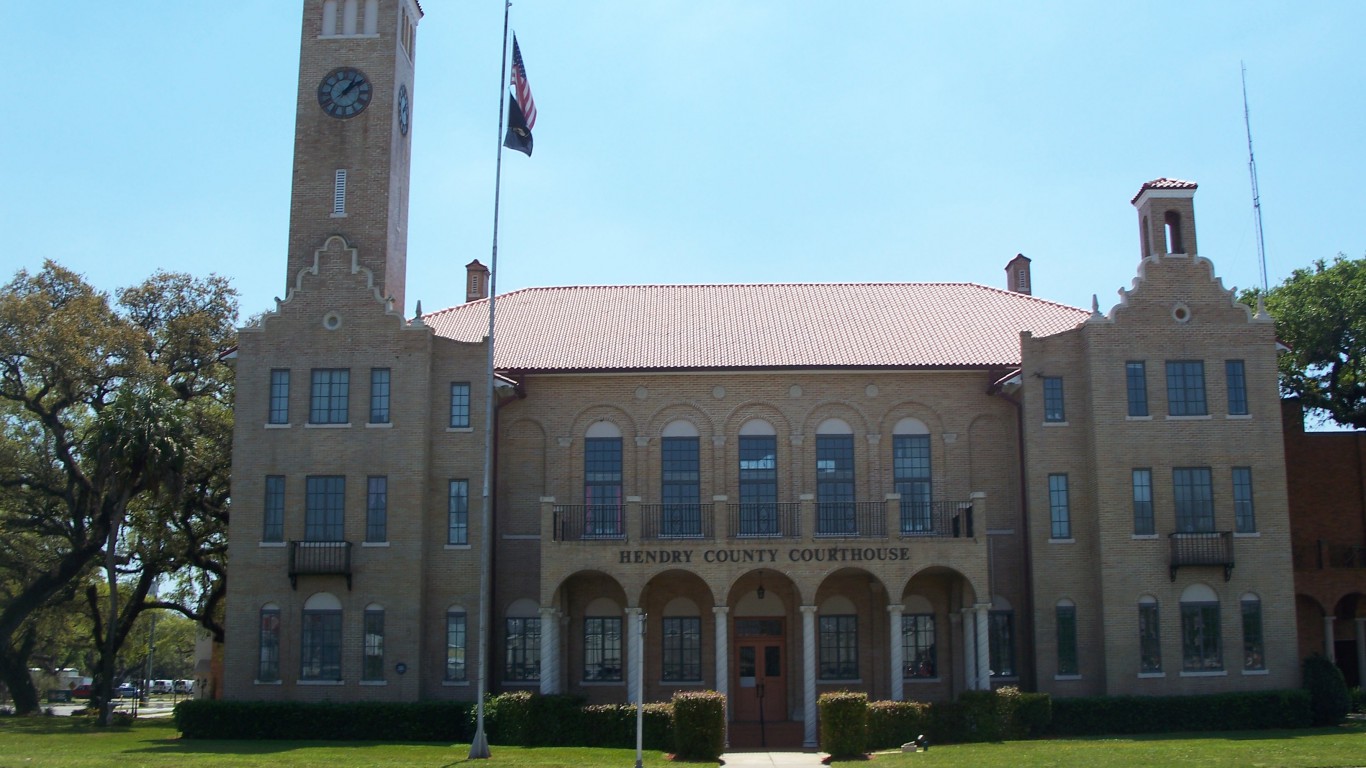
9. Hendry County, Florida
> Confirmed COVID-19 cases as of 5/5/2020: 111 (276.6 per 100,000 — highest 20%)
> Poverty rate: 26.8% (highest 10%)
> Non-white population: 67.3% (highest 10%)
> Population with a disability: 12.7%
> Housing units with more people than rooms: 7.9% (highest 10%)
> Most populated place in county: Clewiston
In Florida’s Hendry County, 26.2% of the population does not have health insurance coverage, one of the largest uninsured populations of any U.S. county. It is the only Florida county where even 20% lack insurance. People who lack insurance are more likely to be unable to afford treatment if they get sick and may be more reluctant to seek help.
Over two-thirds of county residents identify as members of an ethnic or racial minority. The CDC has found that racial and ethnic minority groups in the U.S. have been disproportionately affected by COVID-19, with substantially higher death rates among black and Hispanic Americans than among white Americans.

8. Yazoo County, Mississippi
> Confirmed COVID-19 cases as of 5/5/2020: 151 (539.8 per 100,000 — highest 10%)
> Poverty rate: 32.5% (highest 10%)
> Non-white population: 64.9% (highest 10%)
> Population with a disability: 22.4% (highest 10%)
> Housing units with more people than rooms: 4.1% (highest 20%)
> Most populated place in county: Yazoo City
Yazoo County had a total of 151 confirmed COVID cases as of May 5, which relative to its small population (27,974) means the county may be experiencing one of the most serious outbreaks of any U.S. county.
Poor communities with limited resources consistently struggle more during and after disasters, including outbreaks. Social and economic marginalization of black Americans — through real estate discrimination, for example — has led to concentrations of racial segregation in many of these poor areas. Yazoo County is one of the poorest in the nation and one of the many majority black communities vulnerable to disasters, as identified by the CDC. Approximately one-third of the population lives on poverty wages, one of the highest poverty rates of any place in the country. Income per capita in the county is just $18,866 annually, also one of the lowest such figures anywhere in the U.S. Close to 60% of area residents identify as black, one of the highest shares out of the nation’s over 3,000 counties.

7. Navajo County, Arizona
> Confirmed COVID-19 cases as of 5/5/2020: 800 (735.9 per 100,000 — highest 10%)
> Poverty rate: 28.5% (highest 10%)
> Non-white population: 58.5% (highest 10%)
> Population with a disability: 17.9%
> Housing units with more people than rooms: 8.8% (highest 10%)
> Most populated place in county: Show Low
Most of Navajo County’s 9,949 square miles is Indian reservation land. The Navajo Nation implemented social distancing measures early on in the pandemic, which likely helped slow the spread of the virus. But tribal communities tend to have higher rates of medical conditions like diabetes and heart disease, as well as often poor access to clean water — all likely to worsen the COVID-19 outbreak. As of May 5, there were 736 confirmed cases for every 100,000 people in Navajo County, in the top 10% of U.S. counties. Twenty-two of those cases were fatal.
Navajo County’s economy also relies more than most places on tourism, one of the hardest hit industries in the pandemic. As job losses skyrocket across the country, places like Navajo, which in 2018 had an average unemployment rate of 14.8%, are also especially vulnerable economically.
[in-text-ad-2]

6. Barbour County, Alabama
> Confirmed COVID-19 cases as of 5/5/2020: 45 (174.5 per 100,000)
> Poverty rate: 28.9% (highest 10%)
> Non-white population: 53.9% (highest 20%)
> Population with a disability: 22.2% (highest 10%)
> Housing units with more people than rooms: 3.4% (highest 20%)
> Most populated place in county: Eufaula
Barbour County, located less than 100 miles east of Montgomery, does not have the highest COVID-19 cases in the state, but it is the state’s most vulnerable county to disaster. Of the 67 counties in the state, 25 have higher confirmed COVID-19 cases per 100,000 residents. It is important to note, however, that fewer than 400 tests have been administered in Barbour County, on the low end relative to the population and compared to testing rates nationwide and statewide.
In the CDC’s analysis, Barbour County resembles many of the nation’s communities most vulnerable to disaster, with a relatively poor and large non-white population. Income per capita in the area is less than $19,000 annually, and close to 30% of the population lives in poverty. Approximately half of the county’s population identify as black or African American.
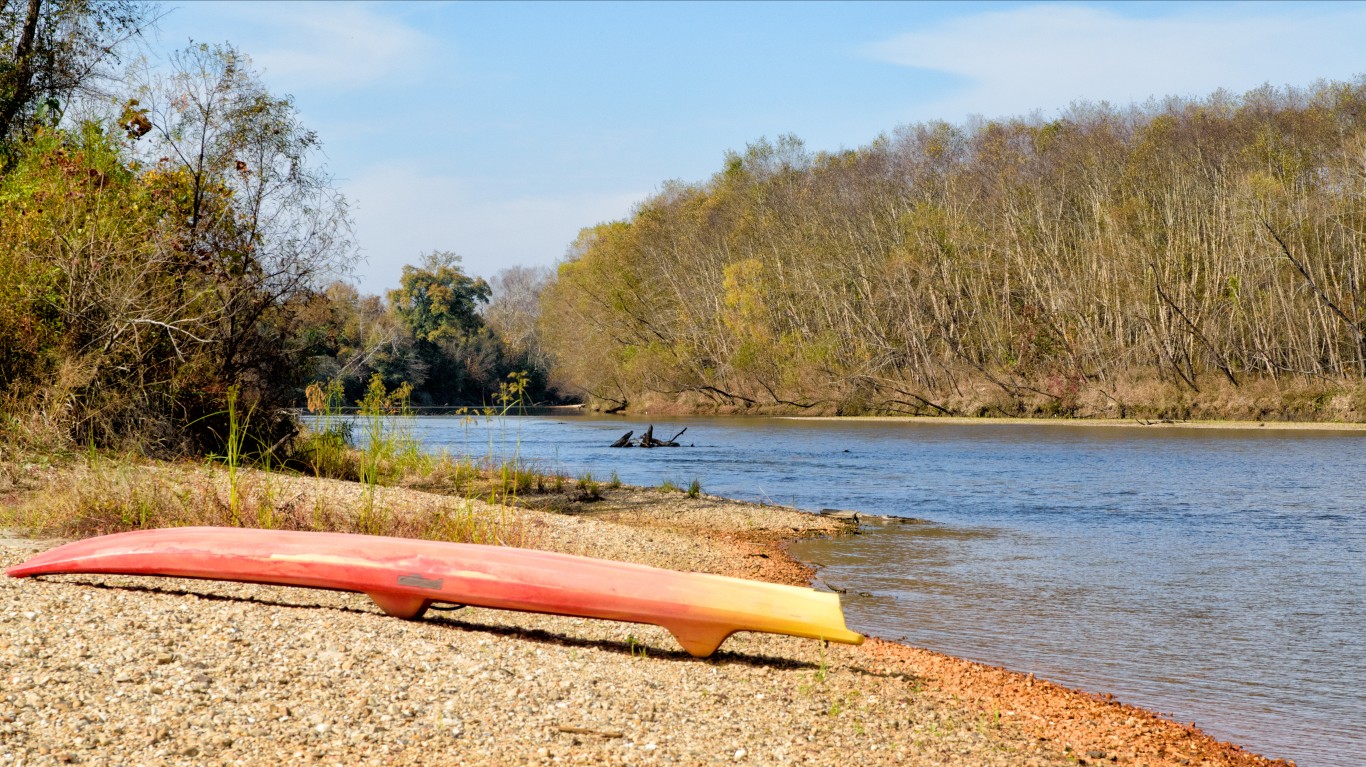
5. Washington Parish, Louisiana
> Confirmed COVID-19 cases as of 5/5/2020: 291 (626.4 per 100,000 — highest 10%)
> Poverty rate: 26.8% (highest 10%)
> Non-white population: 34.4%
> Population with a disability: 23.0% (highest 10%)
> Housing units with more people than rooms: 3.3% (highest 20%)
> Most populated place in parish: Bogalusa
Washington Parish is located in southeast Louisiana, to the north of the city of New Orleans. The parish was also hit hard by Hurricane Katrina in 2005 and struggled to get the resources it needed and restore power.
As of May 5, the Parish has close to 300 reported cases of COVID-19, which relative to its population amounts to one of the highest numbers of cases per capita of any U.S. county or county equivalent. The county also has one of the highest reported COVID-19 deaths per capita from COVID-19.
[in-text-ad]
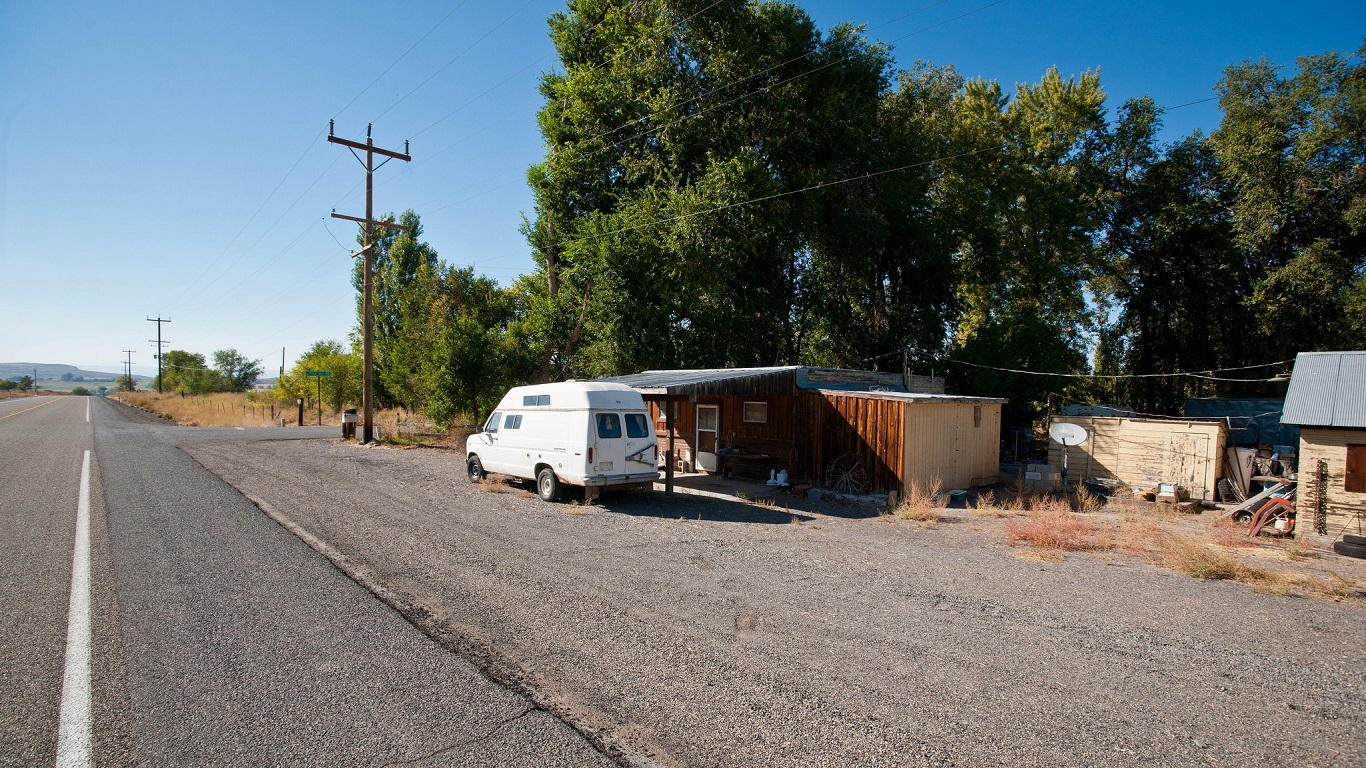
4. Malheur County, Oregon
> Confirmed COVID-19 cases as of 5/5/2020: 13 (42.7 per 100,000)
> Poverty rate: 23.0% (highest 10%)
> Non-white population: 38.6%
> Population with a disability: 16.0%
> Housing units with more people than rooms: 5.5% (highest 10%)
> Most populated place in county: Ontario
Of U.S. counties with populations of 25,000 or more we considered for this ranking, Malheur stands out as having a relatively low confirmed COVID-19 case count — as of May 5, there were about 43 cases per 100,000 people in the county, one of the lowest rates in the nation.
However, with relatively large segments of the county population falling into categories considered to be the most vulnerable during disasters, Malheur is nearly the least prepared place nationwide to endure an outbreak or other disaster. Social and economic marginalization of ethnic and racial minorieis — through real estate discrimination, for example — has contributed to the vulnerabilities in disaster preparedness and recovery common in non-white communities. Close to two in five county residents do not identify as white, and the county as a whole has one of the highest poverty rates in the nation at 23%.
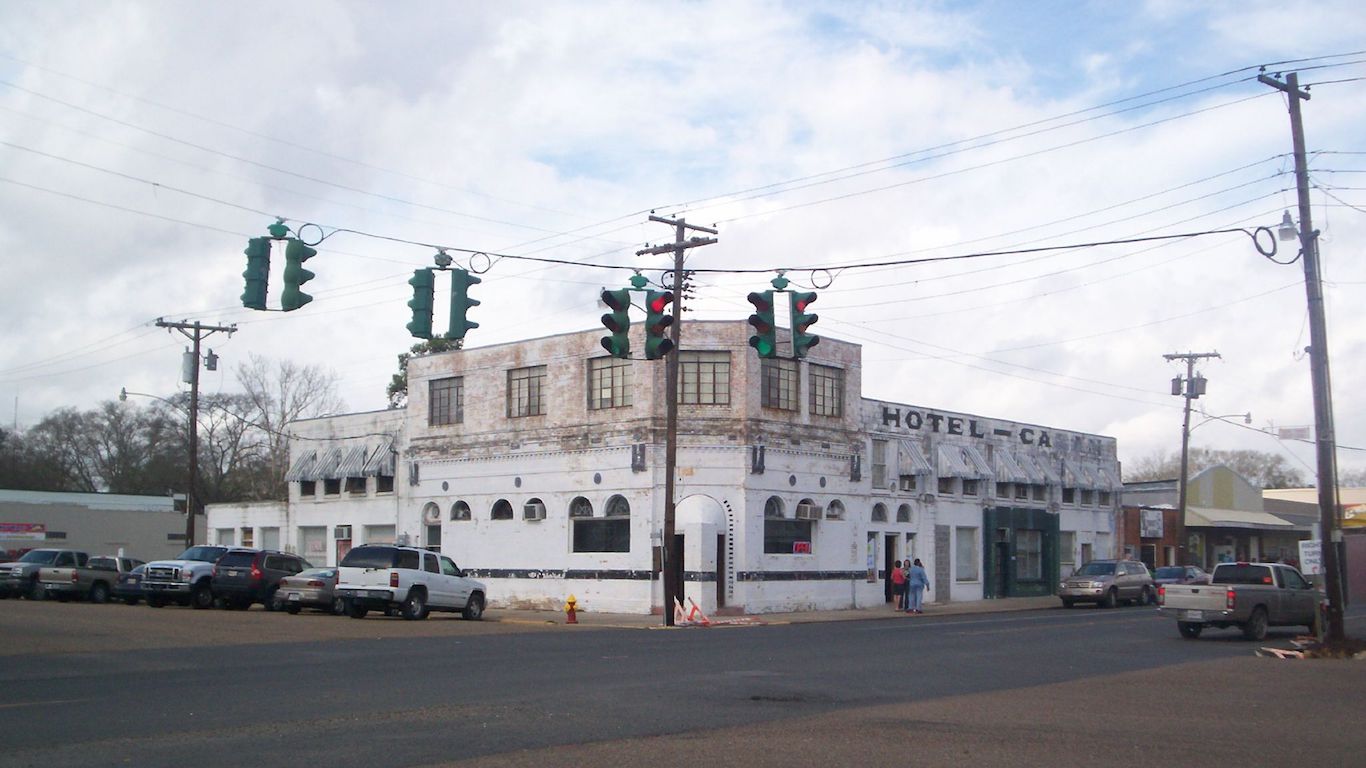
3. Evangeline Parish, Louisiana
> Confirmed COVID-19 cases as of 5/5/2020: 60 (178.4 per 100,000)
> Poverty rate: 27.5% (highest 10%)
> Non-white population: 33.3%
> Population with a disability: 24.2% (highest 10%)
> Housing units with more people than rooms: 3.4% (highest 20%)
> Most populated place in parish: Ville Platte
In Louisiana’s Evangeline Parish, 24.2% of residents have a disability of some kind, one of the highest shares of any U.S. county or county equivalent. People with disabilities, according to the CDC, are more likely to require additional financial support, transportation, and medical care during a disaster. Also according to the CDC, while people with disabilities are not necessarily at higher risk of a severe COVID-19, some people with disabilities might be at greater risk of developing severe disease due to underlying conditions such as chronic lung disease or a weakened immune system.
The parish also has one of the highest poverty rates in the country, as well as a high annual unemployment rate. Those with low incomes and without jobs are much more likely to lack the financial resources needed to weather a prolonged disaster and economic shutdown like in the current crisis.
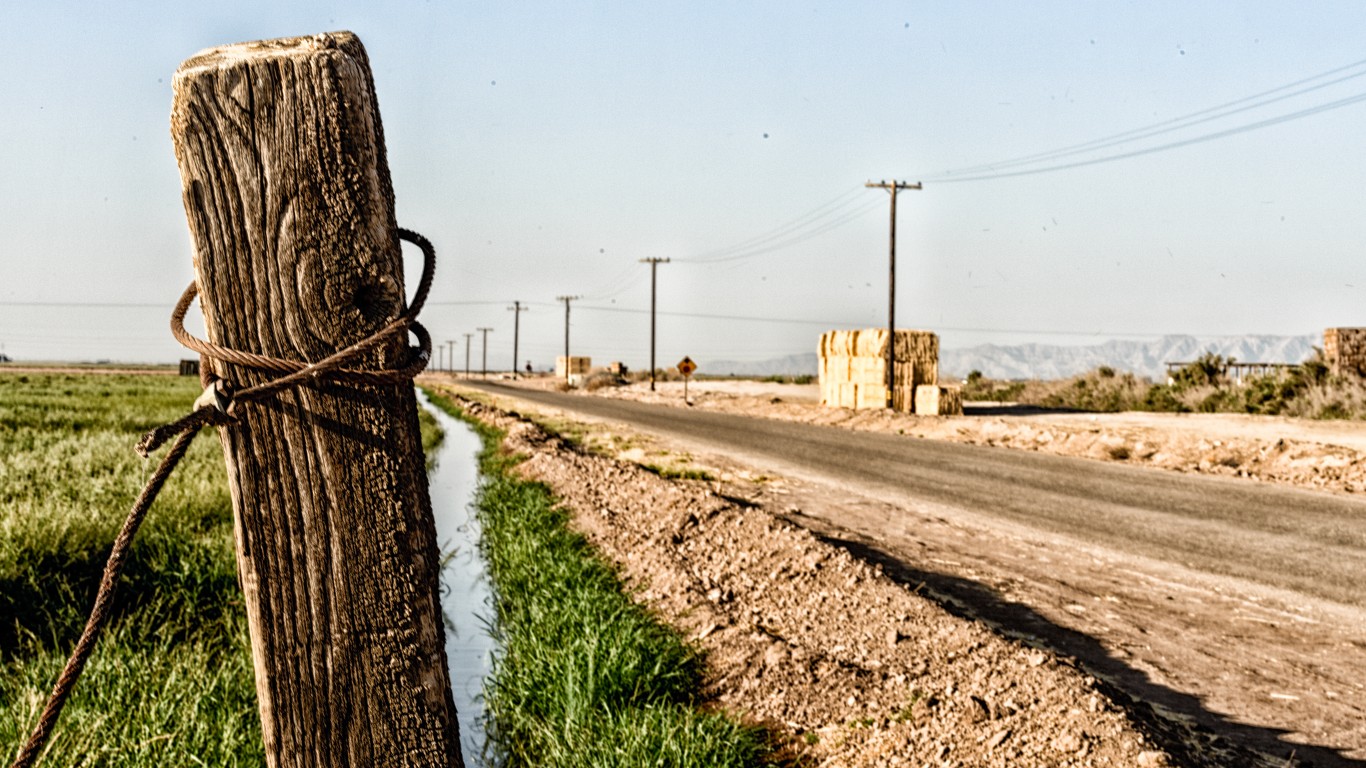
2. Imperial County, California
> Confirmed COVID-19 cases as of 5/5/2020: 379 (210.3 per 100,000)
> Poverty rate: 24.2% (highest 10%)
> Non-white population: 89.0% (highest 10%)
> Population with a disability: 14.4%
> Housing units with more people than rooms: 10.5% (highest 10%)
> Most populated place in county: El Centro
Even after excluding counties with fewer than 25,000 people, many of the most vulnerable communities in the nation have relatively small populations. Imperial County, California, on the other hand is one of the many exceptions with a population of 180,216. With close to 400 cases, or about 210 per 100,000 people, the county’s reported cases suggest it is facing one of the larger case loads in the nation compared to other counties.
The challenge of communicating effectively to everyone within a population can be a major vulnerability factor when facing a disaster like a disease outbreak. For the CDC, one of the drivers of Imperial County’s high vulnerability is its relatively large non-English speaking population. More than 20% of area residents speak English “less than well,” the ninth highest percentage of all counties in the nation and the highest such share of any county on this list.
[in-text-ad-2]
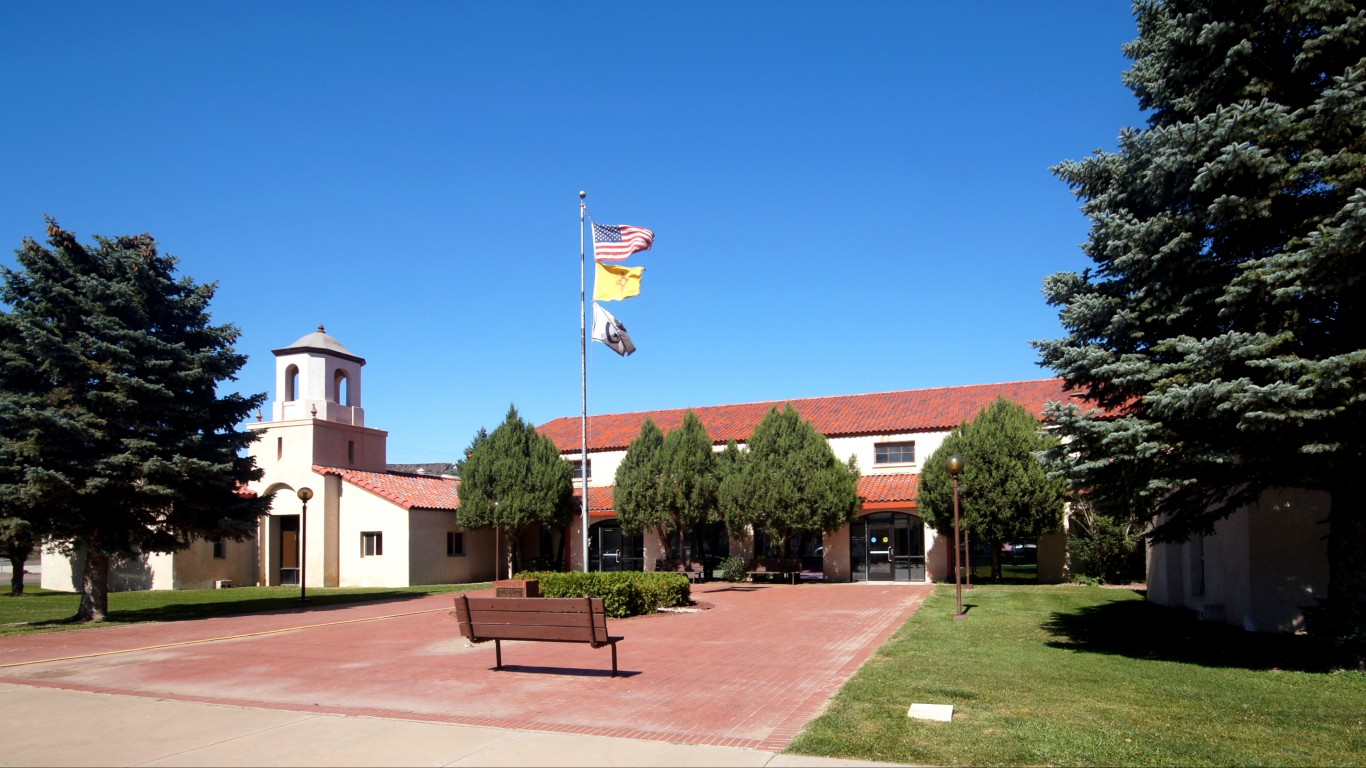
1. Cibola County, New Mexico
> Confirmed COVID-19 cases as of 5/5/2020: 69 (255.8 per 100,000 — highest 20%)
> Poverty rate: 26.5% (highest 10%)
> Non-white population: 80.4% (highest 10%)
> Population with a disability: 24.8% (highest 10%)
> Housing units with more people than rooms: 9.1% (highest 10%)
> Most populated place in county: Grants
Cibola County, New Mexico, ranks as the U.S. county with the most vulnerable population to the effects of a serious disaster, including a pandemic like the one we are currently facing. In the CDC’s Social Vulnerability index, the county ranks above the 90th percentile in nearly all of the 15 components.
The county has a large Latino population, and over 80% of the county is a member of an ethnic or racial minority. The CDC has found that racial and ethnic minority groups in the U.S. have been disproportionately affected by COVID-19, with 74.3 deaths per 100,000 among Hispanic and Latino Americans compared to 45.2 deaths per 100,000 among non-Hispanic white Americans.
Methodology
24/7 Wall St. reviewed the 25 counties and county-equivalents that rank as the most at risk to disaster based on the CDC Social Vulnerability Index. The SVI consists of 15 measures, broken into four themes. The first theme is socioeconomic status, which includes poverty status, unemployment, per capita income, and high school attainment among adults. The second theme is household composition and disability, which includes the share of the population 65 and older, the share of the population 17 or younger, the share of the population older than 5 with a disability, and the share of households that are single-parent households. The third theme is minority status and language and includes the share of the population that does not identify as non-Hispanic white and the share of the population that speaks English “less than well.” The fourth theme, housing and transportation, includes the share of housing units that are in multi-unit structures, the share of housing units that are mobile homes, the share of housing units in which there are more residents than rooms, the share of households that do not have access to a motor vehicle, and the share of residents living in institutionalized group quarters.
All data is for 2018 and comes from the U.S. Census Bureau’s American Community Survey 5-year estimates.
We only considered counties or county equivalents with populations of 25,000 or more.
Retirement can be daunting, but it doesn’t need to be.
Imagine having an expert in your corner to help you with your financial goals. Someone to help you determine if you’re ahead, behind, or right on track. With SmartAsset, that’s not just a dream—it’s reality. This free tool connects you with pre-screened financial advisors who work in your best interests. It’s quick, it’s easy, so take the leap today and start planning smarter!
Don’t waste another minute; get started right here and help your retirement dreams become a retirement reality.
Thank you for reading! Have some feedback for us?
Contact the 24/7 Wall St. editorial team.